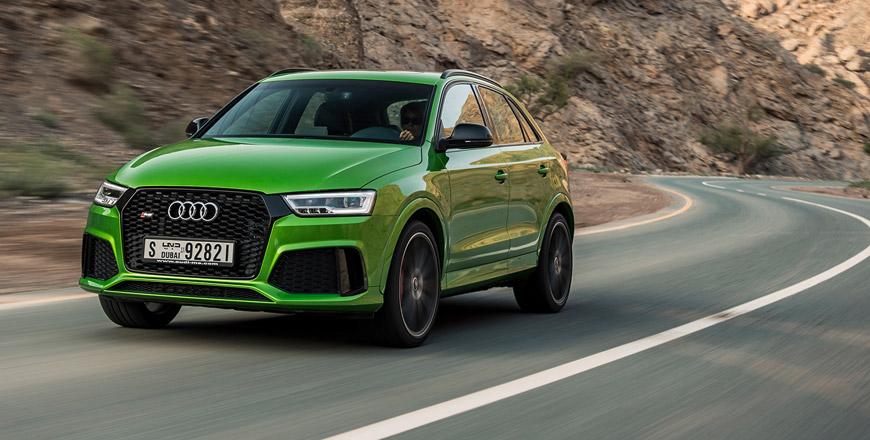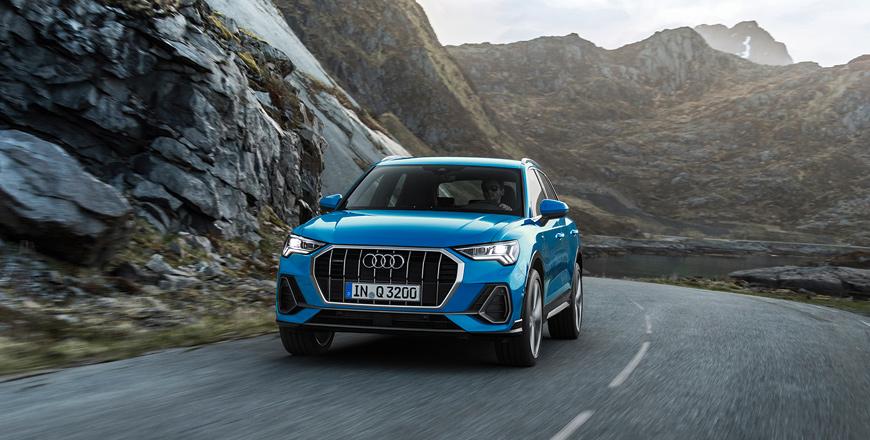You are here
Audi RS Q3 Performance: Punching above its weight
By Ghaith Madadha - May 15,2017 - Last updated at May 15,2017

Photo courtesy of Audi
Somewhere between hot hatch and rally car in character and a practical premium crossover SUV in execution, the Audi RS Q3 Performance is a prodigiously powerful trendsetter in the compact crossover SUV segment, with nary a rival, besides the Mercedes-AMG GLA45. First introduced in 2011, updated in 2015 and with the most powerful Performance arriving last year, the RS Q3 comes courtesy of Ingolstadt’s recently renamed Audi Sport skunkworks division. And, just like Audi’s early and now iconic Quattro and RS2 high performance models, the RS Q3 boasts a brawny, distinctly gurgling and award-winning turbocharged 5-cylinder engine powering all four wheels.
Pouncing posture
Also scooping the Middle East Car of the Year’s Best Compact Premium SUV award for 2017, the RS Q3 is based on a wider and taller version of Audi’s RS3, and shares both much of the driving agility and purposefully eager demeanour of its lower mega-hatch sister. A practical and utilitarian crossover SUV with good cargo space, manoeuvrability and ground clearance to easily dispatch, lumps, bumps, cracks and unpaved roads, the RS Q3 Rides on matt titanium finished 50cm alloy wheels, shod with 255/35R20 tyres, and kitted with 8-piston callipers and drilled ventilated wave design front brake discs for better heat dissipation and fade resistance.
A more aggressive take on the garden-variety Q3 compact crossover SUV, the RS Q3 most notably features more muscular bumpers with larger, hungrier front intakes with lateral slats, and heavily profiled rear air splitter with large oval exhaust tip, which lends it a ready-to-pounce demeanour. Dominated by Audi large signature single frame grille with black honeycomb design, the RS Q3 slim browed headlights are framed by an LED strip for a moodier appearance, while its slanted roofline is finished off with a large tailgate-top spoiler. Meanwhile, the driven model’s “java green” customised paint finish well-reflected the RS Q3 performance’s exuberant character.
Swift and snarling
Powered by a charismatic 2.5-litre turbocharged direct injection 5-cylinder engine mounted transversely and powering all four wheels through a Haldex-derived “quattro” system rather than Audi’s more traditional and signature in-line Quattro system, the RS Q3 is offered in two states of tune. Developing 335BHP and 331lb/ft in base guise and a blistering 362BHP at 5550-6800rpm and 343lb/ft throughout a broad 1625-5550rpm band in Performance spec, as driven, the RS Q3 is among the world’s quickest production SUVs. Digging its four driven wheels tenaciously into tarmac and with quick spooling turbo and succinct and swift shifting 7-speed dual-clutch automated gearbox, the RS Q3 launches viciously from standstill, and pulls with consistent verve to high speeds.
Quicker accelerating than many more expensive and powerful sports SUVs including the Porsche Macan Turbo and Range Rover Sport SVR, the lighter, smaller and nimbler Audi RS Q3 Performance dispatches the 0-100km/h dash in just 4.4-seconds and with optional speed de-restriction, can attain a 270km/h top speed. Snarling, gurgling and growling with a unique off-beat 5-cylinder note, the RS Q3 Performance suffers virtually no turbo lag. Pulling hard from low revs and with an avalanche of mid-range torque, it pulls with muscular confidence and urgency at virtually any speed or gear, while power wells up is a progressive yet prodigious burst, under-written by its generous mid-range and peaking at a broad top-end.
Versatile and agile
Versatile at mid-range and punchy at top-end, the RS Q3’s gearing features a short and aggressive first ratio to help achieve its remarkable acceleration, and long and relaxed sixth and top gears for refined motorway cruising and moderate 8.6l/100km combined fuel consumption. Delivering power to all four wheels with a front-bias in normal conditions, the RS Q3’s centre multi-plated clutch differential can re-allocate power between front and rear to ensure traction and grip is available where required through corners and on loose surfaces. Gearbox shift modes include a more aggressive “dynamic” mode for quicker responsiveness, while one can also use steering wheel-mounted paddles for more engaging sequential manual shifts.
Riding on MacPherson strut front and multi-link rear suspension with standard fixed rate, or optional adaptive, dampers, the RS Q3 is certainly on the firm side to maintain good body control through hard-driven and tight corners, but nonetheless remains settled at speed, comfortable for daily driving and forgiving over imperfections. Driven with fixed rate dampers, the RS Q3 finds a happy medium for sporty driving and usability. Brutishly swift though eager and nimble, the compact RS Q3 may not be as agile as its lower and lighter RS3 sister, and is as close to a hatch as tall SUVs get, with its manoeuvrability through winding roads and tight corners.
Eager and engaging
With relatively short wheelbase and wide track, the RS Q3 turns-in with eager poise, gripping hard on the way in and out, all the while turning with ease and agility as power is reallocated rearwards before it pounces out onto the straight. Meaty and quick at 2.7-turns lock-to-lock, the RS Q3’s electric-assisted steering is direct and precise. It is more refined than textured in terms of feel for the road, but allowing one to keep both hands at quarter-to-three through even the tightest corners. Committed, composed, reassuring and somewhat playful when through corners, the RS Q3 is nevertheless settled and buttoned down on rebound, while cabin and ride refinement is commendable.
Accommodating, user-friendly, sporty and luxurious inside, the RS Q3 Performance’s cabin is more generously spaced than anticipated. Front seating is well-adjustable, supportive and comfortable, with a commanding, alert and engaging driving position, while rear seats feature better rear headroom than expected and boot volume increasing from 356- to 1261-litres with rear seats folded.
Intuitively layouts include clear large instrumentation, thick flat-bottom steering when and pop-up infotainment screen from which driving modes are accessed. Contrast stitched leather upholstery, carbon-fibre trim and soft textures are plenty, while standard and optional equipment is extensive, including panoramic roof, Bose surround sound, adaptive lighting, Bluetooth interface and parking system with reversing camera, in addition to much more.
TECHNICAL SPECIFICATIONS
Engine: 2.5-litre, transverse, turbocharged 5-cylinders
Bore x stroke: 82.5 x 92.8mm
Compression ratio: 10:1
Valve-train: 20-valve, DOHC, direct injection, continuously variable valve timing
Gearbox: 7-speed automated dual clutch, four-wheel-drive, electronic multi-plate clutch and differential lock
Ratios: 1st 3.563; 2nd 2.526; 3rd 1.679; 4th 1.022; 5th 0.788; 6th 0.761; 7th 0.635; R 2.789
Final drive, 1st, 4th, 5th, R/2nd, 3rd, 6th, 7th: 4.733:1/3.944:1
Power, BHP (PS) [kW]: 362 (367) [270] @5550-6800rpm
Specific power: 146BHP/litre
Power-to-weight: 221.7BHP/tonne (unladen)
Torque, lb/ft (Nm): 343 (465) @1625-5550rpm
Specific torque: 187.5Nm/litre
Torque-to-weight: 281Nm/tonne (unladen)
0-100km/h: 4.4-seconds
Top speed: 270km/h
Fuel consumption, urban/extra-urban/combined:
11.8/6.8/8.6-litres/100km
CO2 emissions, combined: 203g/km
Fuel capacity: 64-litres
Wheelbase: 2603mm
Track, F/R: 1571/1577mm
Unladen/kerb weight: 1655kg/1730kg
Steering: Variable assistance rack & pinion
Lock-to-lock: 2.7-turns
Turning Circle: 11.8-metres
Suspension, F/R: MacPherson struts/multi-link
Brakes, F/R: Perforated, ventilated discs, 365 x 34mm/310 x22mm
Brake calipers, F/R: 8-/1-piston
Tyres: 255/35R20
Related Articles
The second smallest of the German manufacturer’s line of various size SUVs and crossovers to suit most tastes, the Audi Q3 is a compact and
A practical high performance brute with turbocharged 5-cylinder engine and resolute four wheel-drive roadholding, the Audi RS3 Sportback is
A niche automotive sub-genre beloved by many diehard petrolheads and auto enthusiasts over high, heavy and lumbering crossovers and SUVs, th


















